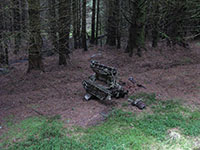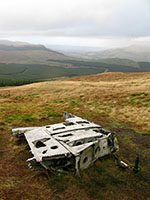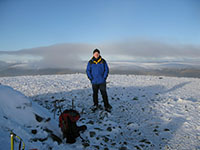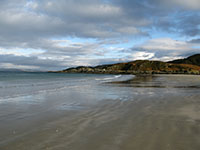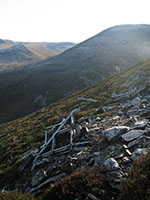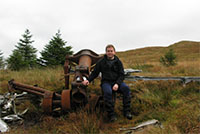Last Friday evening I went on a hillwalking night navigation course run by C-N-Do. I was doing this to get some practice for the ML Award assessment I hope to do at some point this year. The course mostly consisted of a lot of micro-navigation at night across featureless terrain in the western Ochil Hills.
Yesterday I went on a one-day winter skills course organised by C-N-Do. This was a short introductory course and was a review of the basic skills needed to walk in the Scottish mountains in winter. The content of the course was not new to me although it was good to get some formal instruction and practice in some of the techniques, particularly the use of ice-axes and arresting slides on steep snow slopes.
On Monday last week I travelled to Galloway Forest Park to walk near Loch Doon. The weather was pretty bad, with freezing rain, mist and frozen ground underfoot.
I walked in a plantation of fir trees to the southeast of the Loch, west of the Rhinns of Kells ridge, to the site of a Hawker Hurricane that crashed in the Second World War. There is still some wreckage at the site, hidden away in a firebreak in the forest. The wreckage is in danger of disappearing into the new forest growth but the Rolls-Royce Merlin engine from the Hurricane is still visible sitting on the ground underneath the canopy of trees.
You can see my page about this wreck site on my website here.
Last Friday, Lesley and I travelled through to Glasgow to see Porcupine Tree at the O2 ABC venue (previously known as just ‘the ABC’). This is the fourth time I’ve seen Porcupine Tree live (see my two previous blog postings, ‘Porcupine Tree – again‘ and ‘Porcupine Tree‘).
Last Sunday I went for a walk in the Campsie Fells, starting just north of Queenzieburn and walking directly up the escarpment of the Kilsyth Hiils, going via the Birkenburn Reservoir towards the 570m summit of Meikle Bin. It was a gloomy day and the moorland of the Campsie Fells is a pretty desolate and featureless place, even though there are views towards the centre of Glasgow from the high ground.
Last weekend I climbed Ben Chonzie with a work colleague. It was a the first proper winter hillwalk of this year, with ice on the route and a good covering of snow on the broad summit ridge above about 800m. We saw plenty of all-white mountain hares, they are very widespread in this area.
A couple of weekends ago Lesley and I travelled to Arisaig, on the west coast. On the way there we stopped at a couple of places associated with Bonnie Prince Charlie – Glenfinnan and the site on the Sound of Arisaig where he embarked from mainland Scotland after the battle of Culloden.
A couple of weekends ago I went for a short hike over the summit of Carn Aosda near the Glenshee Ski Centre. I walked up to the summit along one of the main paths underneath the ski tows but I descended off the summit into the little-frequented northern corrie of Carn Aosda, Dubh-choire. The conditions were perfect, with frozen ground underfoot and excellent visibility. I had an amazing view of the Cairngorm summits to the north with a covering of fresh snow. You can see a couple of photos I took on the trip on my website here.
Last weekend I went on a NNAS navigation course organised by C-N-Do in Stirling. Some of it was revision for me, but some of it was new, so it was a very useful course. A lot of time was spent doing micro-navigation in pretty featureless terrain in the Touch Hills near Stirling on the Saturday and in the hills north of Callander on the Sunday. Heavy rain on the Sunday added to the navigation challenge.
On Monday I travelled to Argyll to spend the day in the hills between Strachur and Lochgoilhead. The day was mild and dry with no wind and some sunshine in the morning. I walked up Succoth Glen from Strachur, past the secretive waterfall of Eas an Fhithich and up to the rocky 658m summit of Stob na Boine Druim-fhinn. From the summit there were excellent views of Jura and Mull to the west, the summits of Arrochar to the east, a naval ship moored in Loch Goil and the tower-blocks of Greenock and the Firth of Clyde to the south-east. Proof that the best views are not always from the highest hills.
